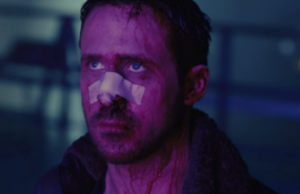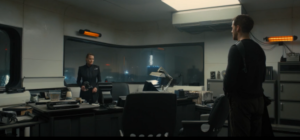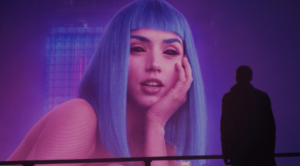76 Blade Runner 2049 (2017)
Beautiful Oppression: Blade Runner 2049
by Elias Frakes
Blade Runner 2049 excels at creating an aesthetic and vibrant aura with its silent beauty and profound philosophical themes. Every scene is artfully crafted, possessing a visual quality rarely seen in other films. The depth of the plot and characters evoke deep emotion and thought that is unexpected for a film of the sci-fi genre. Also unexpected is the film’s critical analysis of what it means to be human, as well as what it might mean for synthetically created beings living amongst humans. In this analysis, an underlying theme of wide-scale discrimination and oppression was also created. The film presents these issues through the use of dialogue, body language, and visual design.
Blade Runner 2049 takes place in a futuristic Los Angeles. The main character, K is a synthetic human being (replicant) employed under the police department and tasked specifically with executing other replicants who rebelled against the system, which attempts to keep them oppressed as a lower working class. Evidence that one of these replicants had given birth was discovered, something previously thought impossible by the creators. This is one of the only clear distinctions between real and fake people. K’s supervisor knows that this evidence may reestablish society’s view of the replicants, thus disturbing the systematic oppression their world relies upon, so she orders K to find and execute the child. He soon realizes that the child may be himself as he begins to question his own role in society. He goes AWOL in his search for truth and is faced by a brutal adversary, a female replicant pet named Luv. The movie’s casual subtlety in usage of female opponents and superiors is refreshing, although the lead role is still filled by a white male.

The film displays a clear difference between the replicants and real human beings. According to Professor Julian Savulescu, “Another issue raised in both [Bladerunner] films is the unjust treatment of the replicants because they are biologically different, though their mental lives turn out to be very similar to ours. In many ways, they are better than us, more humane.” Specifically, through K, a distinct behavioral contrast is shown. In one scene, he walks through his police precinct surrounded by other police. Whenever he walks past one, he pulls the collar of his coat to partially obscure his face and he averts his eyes towards the floor. In comparison to his submissive gestures, his peers act aggressively and direct insults and stares at him. In another scene, he questions the ethics of his supervisor when she orders him to kill someone who was born, not a replicant. To him, to be born is to have a soul, and to have a soul is to have value. She asks if he’s telling her no, to which he responds, “I wasn’t aware that was an option madam”. Before he turns to leave the room, the supervisor remarks, “You’ve been getting on fine without one.” In this statement, she is both referencing the absence of his soul according to his own beliefs and denying his basic humanity. I find these portrayals of difference to be realistic and truthful. The idea of not having any other option but to submit is powerful and sincere.

Differences in power can be seen in the film’s portrayal of women. In this society, women primarily act as sex objects. Rosie Fletcher explains, “Blade Runner 2049 imagines a future where human men have decided the world would be better without human women.” Besides K’s supervisor, this is certainly the case. For example, the AI named Joi is a holographic woman designed to be the ideal romantic partner, seeking only to please and serve. She is stripped of her humanity and acts as an intelligent but submissive sex appeal. Besides Luv, who acts as a compliant foot soldier, female replicants mainly serve the same purpose. In one scene, two of them approach K and are immediately recognized as prostitutes. In another scene, female replicants are referred to as “pleasure models”. I found this outlook on the future to be disturbing, reminiscent of antiquated beliefs and social hierarchies.

Discrimination in Blade Runner 2049 is not as direct as some of the other themes, so you must look more closely at the details. The cast is mostly white, featuring only 5 minorities out of 20 members, obvious evidence of discrimination during the casting. According to Fei Wang, Los Angeles contains nearly 50% Latinos, 10% Asians, and 10% African Americans. Realistically, most of the characters should be non-white. To provide an example of discrimination within the world of Blade Runner, K faces prejudice in the workplace. It is established that due to his replicant status, he is unable to work as an actual policeman and must instead only work to execute other replicants.
In my research for this essay, I encountered a perspective that I had not previously considered. According to Angela Caravan, Blade Runner 2049 is a feminist lesson, as K’s initial and stereotypical masculine sense of importance is broken to reveal the truly special as being female. As previously mentioned, K begins to suspect that he is not a replicant, but a being born from a replicant, which would make him special and valuable. He experiences a deep emotional response due to this realization. However, later in the film, the true child turns out to be a female, who appears indifferent to this knowledge.
When I discovered that I would have to write this essay, I immediately thought of Blade Runner 2049. It is one of my favorite films, both due to its visual beauty and thought-provoking themes. I have also always related to the character K. As he wanders about the dark, futuristic city of LA, he is enshrouded by a romantic solitude. He doesn’t relate with anyone but his fake AI companion, he doesn’t feel real. He is desperate for meaning, grasping for anything that offers fulfillment. I imagine many people in today’s society would see themselves in this portrayal.
Blade Runner 2049 is both a visual masterpiece and an in-depth exploration of profound philosophical ideas. Questioning what it means to be human and discussing what discrimination synthetic humans may face could be an important conversation for the future. Seeing how the discrimination and oppression is displayed through the injustices that K experiences also reflects the past. I would recommend this film to anyone, as all people could appreciate its awe-inspiring sites and use of relevant topics. You will enjoy the relatability of the characters and plot, as the movie is ultimately a projection of the society in which we currently find ourselves.
References
Savulescu, Julian. “Blade Runner 2049: Identity, Humanity and Discrimination.” Pursuit. The University of Melbourne, 13 Mar. 2023, https://pursuit.unimelb.edu.au/articles/blade-runner-2049-identity-humanity-and-discrimi nation.
Fletcher, Rosie. “Blade Runner 2049 Review: A Mind Bending Sci-Fi Noir.” Digital Spy, 30 Nov. 2018, https://www.digitalspy.com/movies/a839281/blade-runner-2049-review/.
Wang, Fei. “Gender and Race Issues in Blade Runner and Blade Runner 2049.” Medium, 8 Jan. 2019, https://medium.com/colored-lenses/gender-and-race-issues-in-blade-runner-and-blade-runner-2049-b2b84b51f45d.
– Caravan, Angela. “Do Androids Dream of Smashing the Patriarchy? Blade Runner 2049 Is a Lesson in Feminism.” Screen Queens, 17 Aug. 2018, https://screen-queens.com/2018/08/28/do-androids-dream-of-smashing-the-patriarchy-blade-runner-2049-is-a-lesson-in-feminism/

